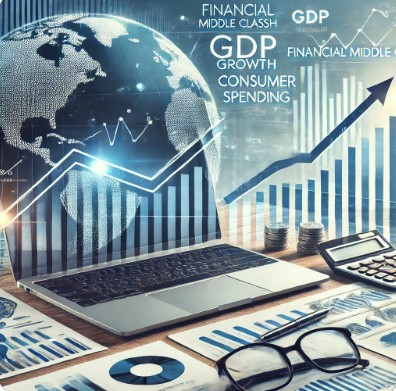The Bureau of Economic Analysis (BEA) report indicates solid economic growth in the third quarter of 2024, with the U.S. real GDP increasing by 2.8% annually. This follows a 3.0% rise in the second quarter, highlighting a slight deceleration but maintaining strong economic momentum.
Key Drivers of Growth
The report attributes the third quarter growth primarily to robust consumer spending, heightened exports, and increased federal government spending.
Consumer spending saw contributions from goods and services alike, with standout increases in prescription drugs, motor vehicles, and healthcare services.
Notably, exports surged, led by capital goods excluding automotive. Federal government expenditure, particularly on defense, also provided a significant boost.
While growth persisted, the deceleration from the previous quarter was linked to a downturn in private inventory investments and a larger decline in residential fixed investments. However, these setbacks were somewhat mitigated by accelerated spending in other areas.
Current-Dollar GDP and Inflationary Trends
In nominal terms, current-dollar GDP rose by 4.7% annually in the third quarter, amounting to a $333.2 billion increase. This marked a slight dip compared to the 5.6% rise in the second quarter.
The report reflects ongoing price stability, with the price index for gross domestic purchases rising just 1.8% compared to 2.4% in the previous quarter. The personal consumption expenditures (PCE) price index also indicated a cooling trend, rising by 1.5% in the third quarter compared to 2.5% in the second. Excluding volatile food and energy prices, the PCE index increased by 2.2%, down from 2.8%.
Personal Income and Savings
Personal income in the current-dollar context increased by $221.3 billion, down from a more substantial $315.7 billion increase in the previous quarter.
Real disposable income growth also slowed to 1.6% from 2.4%. Meanwhile, the personal saving rate fell slightly to 4.8%, reflecting increased spending and a pullback in precautionary savings amid stabilizing economic conditions.
A Rebounding Economy with Persistent Caution
The data paints a picture of an economy still experiencing growth but with signs of easing. On one hand, stronger consumer spending and export gains show resilience, but the drop in private investments and residential real estate remains a red flag. It’s a period marked by caution, as seen in the marginal dips in income and saving rates.
The broader implication of this report is that, while the U.S. economy continues its growth trajectory, there are subtle but meaningful shifts beneath the surface. Policymakers will likely interpret these trends as a signal to remain vigilant, especially given the evolving nature of inflation and income dynamics.
In conclusion, the BEA’s advance GDP estimate underscores both the economy’s strength and its vulnerabilities, with key areas of growth countered by signs of weakening in private investments and personal savings. As we approach the holiday season and the fourth quarter, all eyes will be on consumer behavior and its impact on closing out 2024 on a high note.
